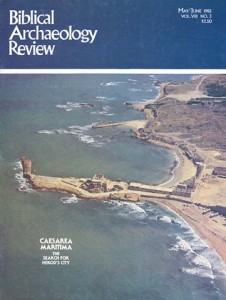Caesarea World Monument
Sidebar to: Caesarea Maritima: The Search for Herod’s City

On warm summer evenings about 2,000 years ago, when Caesarea Maritima was a Roman provincial capital city of a quarter million people, residents would attend performances in the theater on the sea. Leaving the theater, they would stroll north along a thoroughfare 54 feet wide and probably almost a mile long. This main thoroughfare, called the Cardo Maximus, was lined with about 700 columns and was bordered by mosaics.
Now the columns of the Cardo lie broken, by the hundreds, in Caesarea’s harbor and in the sand that covers most of this grand boulevard. Many of the columns are from the Herodian period. Others are from later periods, for the column-lined Cardo continued to be a showcase of Caesarea for hundreds of years after Herod died.
Only a few of these columns have been excavated. But this summer, an ambitious and creative restoration and preservation project will be launched by restoring three columns to their bases on the Cardo Maximus. The Caesarea World Monument project, subject to approval by Israel’s Department of Antiquities, hopes to restore a section of the Cardo. Once again residents of Caesarea, joined by tourists from all over the world, will attend performances in the theater, perhaps concerts given by the Israel Philharmonic Orchestra, and walk along the restored street of columns.
Already a library member? Log in here.
Institution user? Log in with your IP address.

